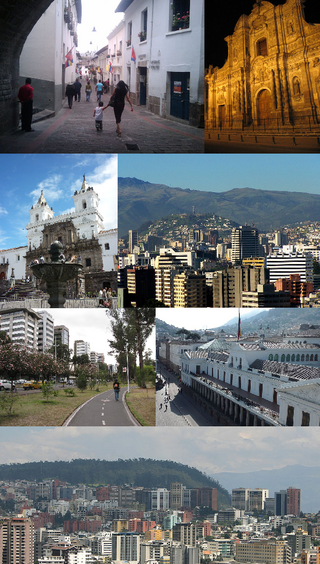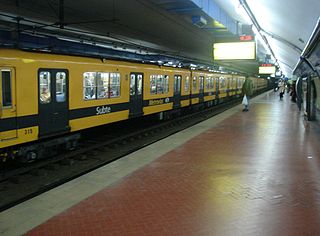
Quito, officially San Francisco de Quito, is the capital of Ecuador, with an estimated population of 2.8 million in its metropolitan area. It is also the capital of the province of Pichincha. Quito is located in a valley on the eastern slopes of Pichincha, an active stratovolcano in the Andes.

The Obelisco de Buenos Aires is a national historic monument and icon of Buenos Aires. Located in the Plaza de la República in the intersection of avenues Corrientes and 9 de Julio, it was erected in 1936 to commemorate the quadricentennial of the first foundation of the city.

Baccalà alla vicentina is a Venetian dish originating in the city of Vicenza. It is made with stockfish, onions, anchovies, milk, and a mature cheese such as Parmesan. Baccalà alla vicentina is considered to be one of the signature dishes of Vicenza.

The Real Audiencia of Quito was an administrative unit in the Spanish Empire which had political, military, and religious jurisdiction over territories that today include Ecuador, parts of northern Peru, parts of southern Colombia and parts of northern Brazil. It was created by Royal Decree on 29 August 1563 by Philip II of Spain in the city of Guadalajara. It ended in 1822 with the incorporation of the area into the Republic of Gran Colombia.

The Obelisk of Montevideo, officially Obelisk to the Constituents of 1830 is a monument created by sculptor José Luis Zorrilla de San Martín (1891-1975). It is a three-sided obelisk made of granite, 40 metres (130 ft) tall with three bronze statues on its sides, representing "Law", "Liberty" and "Force". It has a hexagonal water fountain around it with six spheres on its outer circumference. It is located at the intersection of 18 de Julio and Artigas Boulevard avenues, in Montevideo, at the entrance of the Parque Batlle area. It was built in 1930 to celebrate the 100th anniversary of the first Constitution of Uruguay and is an homage to the participants of the General Assembly of the first Constitution.

Avenida Reforma is a main boulevard in the east-center part of Guatemala City, the capital of Guatemala. It is considered one of the main thoroughfares of Guatemala City. It is 2.26 km (1 mi) in length, and has an average width of 60 meters (197 ft) from sidewalk to sidewalk.
La Vicentina is an electoral parish or district of Quito, Ecuador. The parish was established as a result of the October 2004 political elections when the city was divided into nineteen urban electoral parishes.

Obelisk of São Paulo or Obelisk of Ibirapuera is an obelisk in Ibirapuera Park in the city of São Paulo, Brazil.
The 2010 Recopa Sudamericana de Clubes was a two-legged tie that determined the winner of the Recopa Sudamericana, an annual football match between the winners of the previous season's Copa Libertadores and Copa Sudamericana competitions. It was contested between Argentine club Estudiantes de La Plata and LDU Quito from Ecuador. The first leg was played on August 25 in Quito, while the second leg was played in Quilmes due to Estadio Ciudad de La Plata was undergoing renovations. Estudiantes participated in t the Recopa for their first time ever, having qualified by winning the 2009 Copa Libertadores.

The Caja Madrid Obelisk is an obelisk designed by Santiago Calatrava located in the Plaza de Castilla in Madrid, Spain. The monument—intended to commemorate the 300th anniversary of Caja Madrid—was donated by the savings bank to the city of Madrid.

The Quito School is a Latin American colonial artistic tradition that constitutes essentially the whole of the professional artistic output developed in the territory of the Royal Audience of Quito – from Pasto and Popayán in the north to Piura and Cajamarca in the south – during the Spanish colonial period (1542–1824). It is especially associated with the 17th and 18th centuries and was almost exclusively focused on the religious art of the Catholic Church in the country. Characterized by a mastery of the realistic and by the degree to which indigenous beliefs and artistic traditions are evident, these productions were among of the most important activities in the economy of the Royal Audience of Quito. Such was the prestige of the movement even in Europe that it was said that King Carlos III of Spain (1716–1788), referring to one of its sculptors in particular, opined: "I am not concerned that Italy has Michelangelo; in my colonies of America I have the master Caspicara".
2010–11 season of Argentine football is the 120th season of competitive football in Argentina.

RedTeleSistema (RTS), is a private television station in Ecuador. The channel is owned by Albavisión. The channel is the oldest television station to operate in Ecuador since its inception, HCJB-TV signed on in Quito in 1959 but shut down in 1972.

Carlos Pellegrini is a station on Line B of the Buenos Aires Underground. From here, passengers may transfer to the Diagonal Norte Station on Line C and the 9 de Julio Station on Line D and Metrobus 9 de Julio. The station was opened on 22 July 1931 as the eastern terminus of the extension of the line from Callao. In December 1931, the line was extended further east to Leandro N. Alem.

Diagonal Norte is a station on Line C of the Buenos Aires Underground. From here, passengers may transfer to Carlos Pellegrini Station on Line B or 9 de Julio Station on Line D and Metrobus 9 de Julio. It is located near the Obelisco de Buenos Aires.

Juan O'Neylle was a Spanish Field Marshal (Mariscal) of Spanish-Irish descent. He is best known as one of the commanders during the Spanish defeat at the Battle of Tudela.
Raimon Arola Ferrer, Doctor of Art History and professor at the University of Barcelona, is one of the leading specialists in sacred symbolism, art and Hermetic tradition. He has given numerous seminars in different universities and has collaborated in the journal La Puerta. He is currently the director of Arsgravis and participates in the research group Aula Música Poètica. All of his many publications have international recognition.

Red de Expresos Regionales is a planned commuter network system in Buenos Aires, Consist in a tunnel connecting the 3 mainline railway stations of the city: Retiro, Constitucion and Once, in the north, south and west respectively, The new tunnels we have 2 new stations, the Central Station in the Obelisco and the Correo Central in these building, In Central Station a big interchange to the Underground network in the stations of Lima, Carlos Pellegrini, Diagonal Norte and Avenida de Mayo and 9 de Julio, and the Metrobus BRT network, In Correo Central a new interchange also to the Underground in the namesake station in B and E lines, These tunnels they will reconnect the network of commuters, disconnect since 1897 with the fire and clausure of the Buenos Aires Central Station, construyed by British company Buenos Aires Great Southern Railway and connection of the railways, a few meters of the Plaza de Mayo, The RER system we connect only the routes from Constitución, Retiro and Once, and electric
Liga Deportiva Universitaria de Quito's 1973 season was the club's 43rd year of existence, the 20th year in professional football and the 1st in the Segunda Categoría.

The Monumento a los Niños Héroes, officially Altar a la Patria, is a monument installed in the park of Chapultepec in Mexico City, Mexico. It commemorates the Niños Héroes, six mostly teenage military cadets who were killed defending Mexico City from the United States during the Battle of Chapultepec, one of the last major battles of the Mexican–American War, on 13 September 1847.














